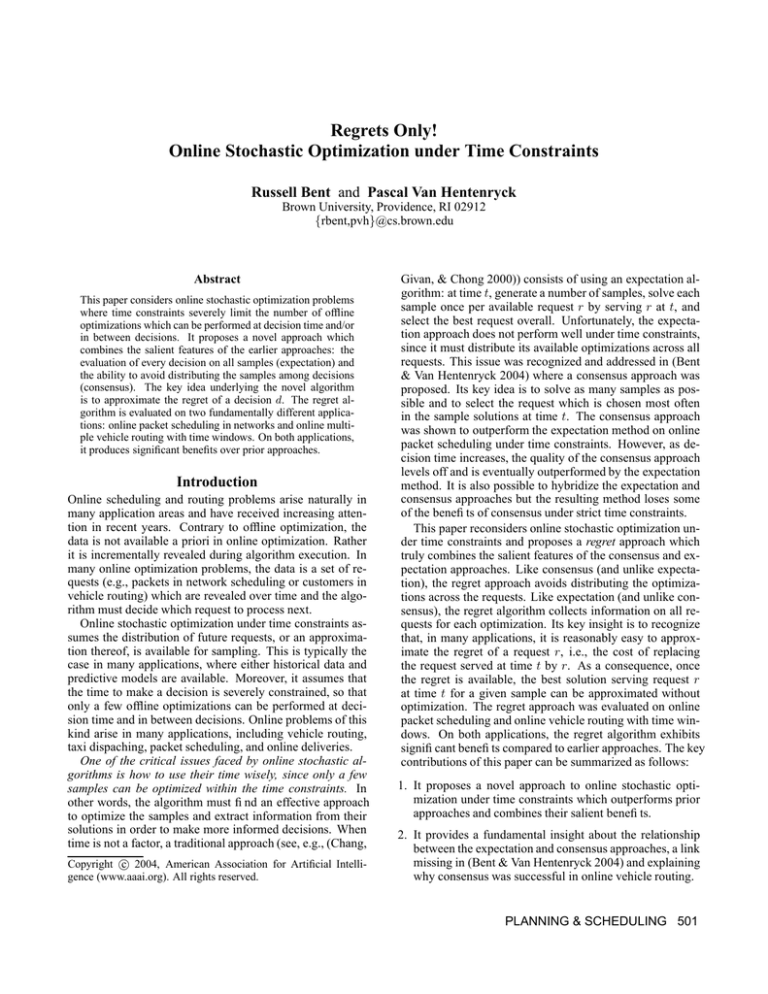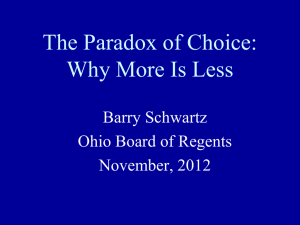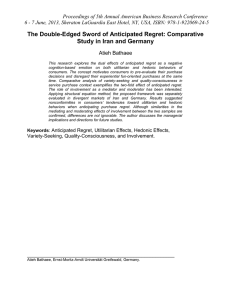
Regrets Only!
Online Stochastic Optimization under Time Constraints
Russell Bent and Pascal Van Hentenryck
Brown University, Providence, RI 02912
{rbent,pvh}@cs.brown.edu
Abstract
This paper considers online stochastic optimization problems
where time constraints severely limit the number of offline
optimizations which can be performed at decision time and/or
in between decisions. It proposes a novel approach which
combines the salient features of the earlier approaches: the
evaluation of every decision on all samples (expectation) and
the ability to avoid distributing the samples among decisions
(consensus). The key idea underlying the novel algorithm
is to approximate the regret of a decision d. The regret algorithm is evaluated on two fundamentally different applications: online packet scheduling in networks and online multiple vehicle routing with time windows. On both applications,
it produces significant benefits over prior approaches.
Introduction
Online scheduling and routing problems arise naturally in
many application areas and have received increasing attention in recent years. Contrary to offline optimization, the
data is not available a priori in online optimization. Rather
it is incrementally revealed during algorithm execution. In
many online optimization problems, the data is a set of requests (e.g., packets in network scheduling or customers in
vehicle routing) which are revealed over time and the algorithm must decide which request to process next.
Online stochastic optimization under time constraints assumes the distribution of future requests, or an approximation thereof, is available for sampling. This is typically the
case in many applications, where either historical data and
predictive models are available. Moreover, it assumes that
the time to make a decision is severely constrained, so that
only a few offline optimizations can be performed at decision time and in between decisions. Online problems of this
kind arise in many applications, including vehicle routing,
taxi dispaching, packet scheduling, and online deliveries.
One of the critical issues faced by online stochastic algorithms is how to use their time wisely, since only a few
samples can be optimized within the time constraints. In
other words, the algorithm must find an effective approach
to optimize the samples and extract information from their
solutions in order to make more informed decisions. When
time is not a factor, a traditional approach (see, e.g., (Chang,
c 2004, American Association for Artificial IntelliCopyright gence (www.aaai.org). All rights reserved.
Givan, & Chong 2000)) consists of using an expectation algorithm: at time t, generate a number of samples, solve each
sample once per available request r by serving r at t, and
select the best request overall. Unfortunately, the expectation approach does not perform well under time constraints,
since it must distribute its available optimizations across all
requests. This issue was recognized and addressed in (Bent
& Van Hentenryck 2004) where a consensus approach was
proposed. Its key idea is to solve as many samples as possible and to select the request which is chosen most often
in the sample solutions at time t. The consensus approach
was shown to outperform the expectation method on online
packet scheduling under time constraints. However, as decision time increases, the quality of the consensus approach
levels off and is eventually outperformed by the expectation
method. It is also possible to hybridize the expectation and
consensus approaches but the resulting method loses some
of the benefits of consensus under strict time constraints.
This paper reconsiders online stochastic optimization under time constraints and proposes a regret approach which
truly combines the salient features of the consensus and expectation approaches. Like consensus (and unlike expectation), the regret approach avoids distributing the optimizations across the requests. Like expectation (and unlike consensus), the regret algorithm collects information on all requests for each optimization. Its key insight is to recognize
that, in many applications, it is reasonably easy to approximate the regret of a request r, i.e., the cost of replacing
the request served at time t by r. As a consequence, once
the regret is available, the best solution serving request r
at time t for a given sample can be approximated without
optimization. The regret approach was evaluated on online
packet scheduling and online vehicle routing with time windows. On both applications, the regret algorithm exhibits
significant benefits compared to earlier approaches. The key
contributions of this paper can be summarized as follows:
1. It proposes a novel approach to online stochastic optimization under time constraints which outperforms prior
approaches and combines their salient benefits.
2. It provides a fundamental insight about the relationship
between the expectation and consensus approaches, a link
missing in (Bent & Van Hentenryck 2004) and explaining
why consensus was successful in online vehicle routing.
PLANNING & SCHEDULING 501
ONLINE O PTIMIZATION(H)
1
2
3
4
5
6
7
8
R ← ∅;
w ← 0;
for t ∈ H
do R ← AVAILABLE R EQUESTS(R, t) ∪ NEW R EQUESTS(t);
r ← CHOOSE R EQUEST(R, t);
SERVE R EQUEST(r, t);
w ← w + w(r);
R ← R \ {r};
Figure 1: The Generic Online Algorithm
3. It evaluates the regret approach on two radically different applications, i.e., online packet scheduling and vehicle routing, which are two extreme points in the spectrum
of online stochastic optimization. On both applications, it
provides significant benefits over earlier approaches.
Online Stochastic Optimization
This section presents the online stochastic optimization
framework. Although the framework is reasonably simple,
it applies directly to a variety of applications (e.g., online
packet scheduling) and can be easily adapted to more complex problems. Its main benefit is to crystallize the main
focus of this paper: how to use a limited number of offline
optimizations to make more informed decisions.
The framework assumes a discrete model of time. Its offline problem considers a time horizon H = [H, H] and a
number of requests R. Each request r is associated with
a weight w(r) which represents the gain if the request is
served. A solution to the offline problem serves a request r
at each time t ∈ H and can be viewed as a function H →
R. Solutions must satisfy the problem-specific constraints
which are left unspecified in the framework.
The goal is to
P
find a feasible solution σ maximizing t∈H w(σ(t)).
In the online version, the requests are not available initially and become progressively available at each time step.
The distribution, which is seen as a black-box, is also available for sampling. The online algorithms have at their disposal a procedure to solve, or approximate, the offline problem. However, at each time step, they may only use the
offline procedure O times because of the time constraints.
More precisely, the approaches presented herein are expressed in terms of the two black-boxes:
1. a function OPTIMAL S OLUTION(R, t) which, given a set
R of requests and a time t, returns an optimal solution for
R over [t, H];
2. a function GET S AMPLE(H) returning a set of requests
over horizon H by sampling the arrival distribution.
Note that, in practice, it may not be practical to sample the
distribution for the entire time horizon. As a consequence,
we simply assume that the samples extend ∆ time steps in
the future, where ∆ is an implementation parameter.
Online Oblivious Algorithms
All the approaches described in this paper share the same
overall structure which is depicted in Figure 1. The approaches only differ in the way they implement function
502
PLANNING & SCHEDULING
CHOOSE R EQUEST . The online optimization schema simply considers the set of available and new requests at each
time step and chooses a request r which is then served and
removed from the set of available requests. Function AVAIL ABLE R EQUEST (R, t) returns the set of requests available
for service at time t and function SERVE R EQUEST(r, t) simply serves r at time t (σ(t) ← r). Subsequent sections specify the online algorithms, i.e., their implementations of function CHOOSE R EQUEST. To illustrate the framework, here is
how two oblivious algorithms, not using stochastic information, can be specified as instantiations of the generic algorithm. These algorithms serve as a basis for comparison.
Greedy (G): This heuristic serves the available request
with highest weight. It can be specified formally as
CHOOSE R EQUEST-G(R, t)
1 A ← READY(R, t);
2
return argmax(r ∈ A) w(r);
Local Optimal (LO): This algorithm chooses the next
request to serve at time t by finding the optimal solution for
the available requests at t. It can be specified as
CHOOSE R EQUEST-LO(R, t)
1 σ ← OPTIMAL S OLUTION(R, t);
2
return σ(t);
Online Stochastic Algorithms
We now review a number of existing stochastic algorithms.
Expectation (E): This is the primary method proposed
by (Chang, Givan, & Chong 2000) for online packet
scheduling. Informally speaking, the method generates
future requests by sampling and evaluates each available
requests against that sample. A simple implementation can
be specified as follows:
CHOOSE R EQUEST-E(R, t)
1 A ← READY(R, t);
2
3
4
5
6
7
8
9
for r ∈ A
do f (r) ← 0;
for i ← 1 . . . O/|A|
do S ← R ∪ GET S AMPLE([t + 1, t + ∆]);
for r ∈ A
do σ ← OPTIMAL S OLUTION(S \ {r}, t + 1);
f (r) ← f (r) + w(r) + w(σ);
return argmax(r ∈ A) f (r);
Line 1 computes the requests which can be served at time t.
Lines 2-3 initialize the evaluation function f (j) for each request r. The algorithm then generates a number of samples
for future requests (line 4). For each such sample, it computes the set R of all available and sampled request at time t
(line 5). The algorithm then considers each available request
r successively (line 6), it implicitly schedules r at time t, and
applies the optimal offline algorithm (line 7) using S \ {r}
and the time horizon. The evaluation of request r is updated
in line 8 by incrementing it with its weight and the score of
the corresponding optimal offline solution σ. All scenarios
are evaluated for all available request and the algorithm then
returns the request r ∈ A with the highest evaluation.
Observe Line 4 of Algorithm E which distributes the
available offline optimizations across all available requests.
CHOOSE R EQUEST-C(R, t)
1
2
3
4
5
6
7
for r ∈ R
do f (r) ← 0;
for i ← 1 . . . O
do S ← R ∪ GET S AMPLE([t + 1, t + ∆]);
σ ← OPTIMAL S OLUTION(S, t);
f (σ(t)) ← f (σ(t)) + 1;
return argmax(r ∈ R) f (r);
Observe line 5 which calls the offline algorithm with all
available and sampled requests and a time horizon starting at
t and line 6 which increments the number of times request
σ(t) is scheduled first. Line 7 simply returns the request
with the largest count. Algorithm C has several appealing
features. First, it does not partition the available samples between the requests, which is a significant advantage when
the number of samples is small and/or when the number of
requests is large. Second, it avoids the conceptual complexity of identifying symmetric or dominated requests.
Consensus+Expectation (C+Ek ): Algorithms E and C
both have advantages and limitations. Algorithm C+E k
attemps to combine their strengths while minimizing their
drawbacks. Letting O = Sc + kSe , its key idea is to run
algorithm C first to identify k promising requests (using Sc
optimizations) and to run algorithm E to discriminate between them in a precise fashion (using kSe iterations).
Limitations of Consensus Figure 2 evaluates the various
approaches on online packet scheduling under different time
constraints (specified by the number of available offline optimizations). The figure exhibits a number of interesting
points. First, it clearly shows that stochastic information
pays off, since consensus is always significantly better than
algorithms G and LO. Second, it shows that consensus significantly outperforms algorithm E when few offline optimizations are available. Third, it shows that consensus lev-
100
O
G
LO
E
C
C+E3
95
90
Average Weighted Loss
When O is small (due to the time constraints), each available request is only evaluated with respect to a small number of samples and hence the expectation method does not
yield much information. This is precisely why online vehicle routing algorithms (Bent & Van Hentenryck 2001) do not
use this method, since the number of requests is very large
(about 50 to 100), time between decisions is limited, and the
optimization is computationally demanding.
Note also that practical implementations of Algorithm E
must be careful to avoid distributing the samples across similar requests and/or to avoid evaluating requests which are
formally dominated by others. These problem-specific considerations can be encapsulated in function READY.
Consensus (C): We now turn to a consensus algorithm
which uses stochastic information in a fundamental different
way. Algorithm C was introduced in (Bent & Van Hentenryck 2004) as an abstraction of the sampling method used
in online vehicle routing (Bent & Van Hentenryck 2001).
Instead of evaluating each possible request at time t with
respect to each sample, algorithm C executes the offline
algorithm on the available and sampled requests and to
count the number of times a request is scheduled at time t
in each resulting solution. Then the request with the highest
count is selected. Algorithm C can be specified as follows:
85
80
75
70
65
0
20
40
60
80
100
120
140
Maximum Number of Offline Optimizations
160
180
200
Figure 2: Existing Algorithms on Online Packet Scheduling
els off and is dominated by algorithm E when the number
of available optimizations increases. Finally, the hybrid algorithm exploits some of the benefits of C and E, but it is
dominated by C when there are few offline optimizations
available. Note also that the bottom line is the offline solution, i.e., a lower bound.
Consensus appears to have two main limitations. First,
it is purely qualitative as it ignores the score of the optimal
solutions. Second, it is extremely elitist in that only the optimal choice receives a credit for a given sample. The first
limitation can be addressed by crediting the value of the optimal solution instead of incrementing a counter, i.e., replacing line 6 by f (σ(t)) ← f (σ(t))+w(σ); This “quantitative”
consensus QC does not bring many benefits on the online
packet scheduling and vehicle routing problems, where this
modification seem to favor the best requests even more.
The real limitation of consensus is its elitism. Only the
best request is given some credit for a given sample, while
other requests are simply ignored. It ignores the fact that
several requests may be essentially similar with respect to
a given sample. Moreover, it does not recognize that a request may never be the best for any sample, but may still be
extremely robust overall. The fundamental issue is thus to
determine if it is possible to gather that kind of information
from the sample solutions without solving additional optimization problems.
The Regret Online Stochastic Algorithm
The key insight to resolve this issue lies in the recognition
that, in many applications, it is possible to quickly estimate
the regret of a request r at time t, i.e., the difference in objective value between the optimal solution σ and the best
solution serving request r at time t.
Definition 1 (Regret) Let R be the set of requests at time
t, r ∈ READY (R, t), and σ = OPTIMAL S OLUTION(R, t).
The regret of r wrt R and t, denoted by REGRET(R, t, r), is
defined as
w(σ) − (w(r) + w(OPTIMAL S OLUTION (R, t + 1))).
This paper assumes the availability of an applicationspecific regret function REGRET UB which provides an up-
PLANNING & SCHEDULING 503
per bound to the regret, i.e.,
REGRET UB(σ, R, t, r)
≥ REGRET(R, t, r).
for σ = OPTIMAL S OLUTION(R, t). Of course, the computational complexity of REGRET UB is assumed to be negligible compared to the cost of the offline optimization.
Such regret approximations typically exist in practical
applications. In an online facility location problem, the
regret of opening a facility f can be estimated by evaluating
the cost of closing the selected facility σ(t) and opening
f . In vehicle routing, the regret of serving a customer c
next can evaluated by swapping c with the first customer
on the vehicle serving c. In packet scheduling, the regret
of serving a packet p can be estimated by swapping and/or
serving a constant number of packets. In all cases, the
cost of approximating the regrets is small compared to
the cost of the offline optimization. The experimental
sections discuss the regrets for specific applications in
detail. Note that there is an interesting connection to
local search, since computing the regret may be viewed
as evaluating the cost of a local move for the application
at hand. We are now ready to present the regret algorithm R:
Of course, an exact computation of the regret typically requires an offline optimization. Algorithm QC, the “quantitative” version of consensus, is simply algorithm R with the
worst-case regret, i.e., REGRET UB(σ, R, t, r) = w(σ). As a
consequence, algorithms E and QC are two extreme instantiations in the spectrum of regret algorithms. Alternatively,
algorithm E may be viewed as an ideal to achieve but time
constraints make it impractical. Algorithm R then provides a
general way to obtain fast approximations using regrets and
QC is its worst-case instantiation.
Readers may wonder, as we did, why the “qualitative”
version of consensus behaves so well in online vehicle routing and packet scheduling. The basic reason is that the difference between an optimal choice σ(t) at time t and another
available choice r is typically very small (we will come back
to this issue later in the paper). It is over time that significant
differences between the algorithms accumulate.
Packet Scheduling
As a consequence, every available request is given an evaluation value for every sample at time t for the cost of (essentially) a single offline optimization. Observe that algorithm
R performs O offline optimizations at time t.
This section reports experimental results on the online
packet scheduling problem was initially proposed by
(Chang, Givan, & Chong 2000) to study the benefits of
stochastic information on the quality of the schedules.
Problem Description The offline version can be specified
as follows. We are given a set Jobs of jobs partitioned into a
set of classes C. Each job j is chararacterized by its weight
w(j), its arrival date a(j), and its class c(j). Jobs in the
same class have the same weight (but different arrival times).
We are also given a schedule horizon H = [H, H] during
which jobs must be scheduled. Each job j requires a single time unit to process and must be scheduled in its time
window [a(j), a(j) + d], where d is the same constant for
all jobs (i.e., d represents the time a job remains available to
schedule). In addition, no two jobs can be scheduled at the
same time and jobs that cannot be served in their time windows are dropped. The goal is to find a schedule of maximal weight, i.e., a schedule which maximizes the sum of
the weights of all scheduled jobs. This is equivalent to minimizing weighted packet loss. More formally, assume, for
simplicity and without loss of generality, that there is a job
scheduled at each time step of the schedule horizon. Under
this assumption, a schedule is a function σ : H → Jobs
which assigns a job to each time in the schedule horizon. A
schedule σ is feasible if
Relationships between E, C, R
∀ t1 , t2 ∈ H : t1 6= t2 → σ(t1 ) 6= σ(t2 )
∀ t ∈ H : a(σ(t)) ≤ t ≤ a(σ(t)) + d.
CHOOSE R EQUEST-R(R, t)
1
2
3
4
5
6
7
8
9
for r ∈ R
do f (r) ← 0;
for i ← 1 . . . O
do S ← R ∪ GET S AMPLE([t + 1, t + ∆]);
σ ← OPTIMAL S OLUTION(S, t);
f (σ(t)) ← f (σ(t)) + w(σ);
for r ∈ READY(R, t) \ {σ(t)}
do f (r) ← f (r) + (w(σ) − REGRET UB(σ, R, t, r));
return argmax(r ∈ R) f (r);
Its basic organization follows algorithm QC, the “quantitative” version of consensus. However, instead of assigning
some credit only to the request selected at time t for a given
sample s, algorithm R (lines 7-8) uses the regret estimation
to compute, each available request r, an approximation of
the best solution of s serving r at time t, i.e.,
w(σ) − REGRET UB(σ, R, t, r).
The regret algorithm combines the salient features of the expectation and consensus algorithms. Like C (and unlike E),
it considers O samples and avoids distributing the offline optimizations among the requests. Like E (and unlike C), each
available request is evaluated for every sample. As a consequence, the algorithm combines the fundamental features of
both approach and addresses their limitations.
The regret algorithm also establishes a clear relationship
between the algorithms. Indeed, algorithm E is simply algorithm R with an exact regret, i.e.,
REGRET UB(σ, R, t, r)
504
= REGRET(R, t, r).
PLANNING & SCHEDULING
The weight
P of a schedule σ, denoted by w(σ), is given by
w(σ) = t∈H w(σ(t)). The goal is to find a feasible schedule σ maximizing w(σ). This offline problem can be solved
in quadratic time O(|J||H|).
Experimental Setting The experimental evaluation is
based on the problems of (Chang, Givan, & Chong 2000;
Bent & Van Hentenryck 2004), where all the details can be
found. In these problems, the arrival distributions are specified by independent HMMs, one for each job class. The results are given for the reference 7-class problems and for an
online schedule consisting of 200,000 time steps. Because
100
O
G
LO
E
C
C+E3
95
R
Average Weighted Loss
90
85
80
75
70
65
0
20
40
60
80
100
120
140
Maximum Number of Offline Optimizations
160
180
200
Figure 3: The Regret Algorithm on Packet Scheduling
it is unpractical to sample the future for so many steps, the
algorithms use a sampling horizon of 50, which seems to be
an excellent compromise between time and quality.
The Regret Function The online packet scheduling fits
directly in the online stochastic framework of this paper. To
evaluate the algorithms, it suffices to specify how to compute
an upper bound to the regret. Our experimental evaluation
uses a fast approximation based on a simple case analysis.
Consider a job r ∈ READY(R, t). If job r is not scheduled
(i.e., r ∈
/ σ), the key idea is to try rescheduling σ(t) instead
of the job of smaller weight in σ. The regret becomes
min(s ∈ [t, a(σ(t)) + d]) w(σ(s)) − w(r)
since the replaced job is removed from σ and r is added to
the schedule. In the worst case, the replaced job is σ(t) and
the regret is w(σ(t)) − w(r). If job r is scheduled at time
tr , the key idea is to select the best possible unscheduled job
which may be scheduled at tr . The regret now becomes
w(σ(t)) − max(r ∈ Ur ) w(u)
where Ur = {j ∈ READY (R, tr ) | j ∈
/ σ}, since job
σ(t) is lost in the schedule and job j is in the schedule already. Note that, in the best case, job σ(t) is inserted at
time tr , in which case the regret is 0. This upper bound is
O(max(d, |C|)), which is sublinear in |J| and |H| and essentially negligible for this application.
The Results Figures 3 compares the various algorithms on
the 7-class problems. The benefits of the regret algorithm
are clearly apparent. Algorithm R indeed dominates all the
other algorithms, including consensus (C) when there are
very few offline optimizations (strong time constraints) and
expectation (E) even when there are a reasonably large number of them, (weak time constraints).
Vehicle Routing
We now evaluate the regret algorithm on a significantly more
complicated problem: online multiple vehicle routing with
time windows. This problem was studied initially in (Bent
& Van Hentenryck 2001) to show the value of stochastic information in vehicle routing.
Problem Formulation The vehicle routing problems are
specified formally in (Bent & Van Hentenryck 2001) where
all the details can be found. Each problem contains a depot,
a number of customer regions and a number of customer service requests from the regions. Each request has a demand,
a service time, and a time window specified by an interval
[e, l], which represents the earliest and latest possible arrival
times respectively. There are a number of identical vehicles available for use, each with capacity Q. A vehicle route
starts at the depot, serves some customers at most once, and
returns to the depot. The demand of a route is the summation of the demand of its customers. A routing plan is a
set of routes servicing each customer exactly once. A solution to the offline VRPTW is a routing plan that satisfies
the capacity constraints on the vehicle and the time window
constraints of the requests. The objective is to find a solution maximizing the number of served customers. In the
dynamic VRPTW, customer requests are not known in advance and become available during the course of the day. In
general, a number of requests are available initially.
The online VRPTW is much more complicated than the
online packet scheduling and does not fit directly in the
stochastic framework presented earlier. First, decisions are
triggered by two types of events: new customer requests and
the arrival of a vehicle at a customer site. Second, a decision consists of choosing which customers to serve next
on a given vehicle. Third, the online algorithm must decide whether to accept or reject customer requests immediately and must service the accepted requests. Finally, the
VRPTW is a hard NP-complete problem whose instances
are extremely difficult to solve optimally. Only 2 to 10 offline optimizations can be solved in between two events and
the number of events is large (e.g., 50 different requests).
Hence, the expectation method is not practical at all.
Experimental Setting The experimental results are based
on the class-4 problems from (Bent & Van Hentenryck
2001), where all details can be found. They are derived
from the Solomon benchmarks which are very challenging
and involve 100 customers. The 15 instances exhibit various degrees of dynamism (i.e., the ratio between known and
dynamic customers), different distributions of early and late
requests, as well as time windows of very different sizes.
Hence they cover a wide spectrum of possibilities and structures. The number of vehicles available for the dynamic
algorithms was determined by solving the offline problems
and adding two vehicles.
The Stochastic Algorithm The experimental evaluation is
based on the MSA algorithm proposed in (Bent & Van Hentenryck 2001). This algorithm continously generates samples and “solves” the offline problems using large neighborhood search (LNS) (Shaw 1998). Plans are kept by the
MSA algorithm as long as they are consistent with the decisions. This makes it possible to have a reasonable number of
samples on which to base the decisions, since only very few
samples can be solved in between events. This is due partly
to the complexity of solving these complex vehicle routing
problems and partly to the short time between events. In
general, only a small number of samples (about 5) are avail-
PLANNING & SCHEDULING 505
Prob
20-20-60-rc101-1
20-20-60-rc101-2
20-20-60-rc101-3
20-20-60-rc101-4
20-20-60-rc101-5
DOD
46.3%
45.8%
50.0%
45.6%
47.4%
MSAc
3.00
4.32
3.24
5.08
6.08
MSAr
3.48
4.84
3.46
5.38
5.72
20-20-60-rc102-1
20-20-60-rc102-2
20-20-60-rc102-3
20-20-60-rc102-4
20-20-60-rc102-5
59.0%
57.5%
56.0%
52.0%
57.6%
1.10
3.66
4.12
2.58
2.88
1.94
3.70
3.60
3.12
2.90
20-20-60-rc104-1
20-20-60-rc104-2
20-20-60-rc104-3
20-20-60-rc104-4
20-20-60-rc104-5
76.1%
75.6%
76.1%
72.2%
74.4%
13.38
13.86
10.64
14.32
13.38
11.26
12.16
8.98
9.42
10.20
Figure 4: Regret on Online Vehicle Routing
able to make a decision. The main goal of our experimental
evaluation is to evaluate two versions of the MSA algorithm:
M SAc which uses consensus to choose the next customer on
a given vehicle and M SAr which uses regret for the same
decision. The rest of the algorithm is left unchanged.
The Regret Function The regret function is simple and
fast. Consider the decision of choosing which customer to
serve next on vehicle v and let s be the first customer on the
route σ of vehicle v. To evaluate the regret of another customer r on a vehicle v, the key idea is to determine if there
is a feasible swap of r and s on v, in which case the regret
is zero. Otherwise, if such a swap violates the time window
constraints, the regret is 1. The main benefit of this regret
function is to recognize that some choices of customers are
essentially equivalent.
Results Table 4 depicts the results on the 15 instances of
the Solomon benchmarks. Each instance is solved 50 times
because of the nondeterministic nature of the sampling and
LNS algorithms. The second column gives the degree of dynamism and the third and fourth columns report the number
of missed customers by M SAc and M SAr . The regret algorithm does not bring any benefit on the first two classes of
problems with lower degrees of dynamism. However, it produces some dramatic improvements on the third class of instances, where the degree of dynamism is high (about 70%)
inducing stricter time constraints. On this last class, the regret algorithm reduces the number of missed customers by
about 35% on some problems and always produces reductions above 12%. This is a very interesting result, since
consensus is particularly effective on these problems. Indeed, at a time t, the difference in the number of missed customers between a good and a bad choice is typically 1 and
hence consensus is already a very good approximation of
E. However, by recognizing “equivalent” choices, the regret
algorithm further improves the approximation and produces
significant benefits for the most time-constrained instances.
Related Work
Online algorithms (e.g., (Fiat & Woeginger 1998)) have
been addressed for numerous years but research has tradi-
506
PLANNING & SCHEDULING
tionally focused on techniques oblivious to the future and
on competitive ratios (Karlin et al. 1988). It is only recently
that researchers have begun to study how information about
future uncertainty may improve the performance of algorithms. This includes scheduling problems (Chang, Givan,
& Chong 2000), vehicle routing problems (Bent & Van Hentenryck 2001), (Cambell & Savelsbergh 2002) and elevator
dispatching (Nikovski & Branch 2003) to name a few. Research on these problems has varied widely, but the unifying theme is that probabilistic information about the future
significantly increases quality. The expectation method was
the primary method used in (Chang, Givan, & Chong 2000),
They also pointed out why POMDPs are too general for this
class of problems. The consensus approach was motivated
by online stochastic vehicle routing (Bent & Van Hentenryck 2001) and applied to online packet scheduling in (Bent
& Van Hentenryck 2004).
Conclusion
This paper proposed a novel algorithm for online stochastic
optimization under time constraints. Like the consensus approach, the new regret algorithm solves as many samples as
possible and avoids distributing them among requests. Like
the expectation approach, it extracts information on all available requests for every sample by using an upper bound to
the regret. The novel algorithm was evaluated on two very
different applications, online packet scheduling and online
vehicle routing, and was shown to outperform prior algorithms significantly in most cases. Moreover, the regret algorithm provides a fundamental insight in the relationships between the expectation and consensus approaches. This link,
which was missing in earlier work, explains why consensus
was so successful in online vehicle routing.
Acknowledgment
This research is partially supported by NSF ITR Award
DMI-0121495.
References
Bent, R., and Van Hentenryck, P. 2001. Scenario Based Planning
for Partially Dynamic Vehicle Routing Problems with Stochastic
Customers. Operations Research. (to appear).
Bent, R., and Van Hentenryck, P. 2004. The Value of Consensus
in Online Stochastic Scheduling. In ICAPS 2004.
Cambell, A., and Savelsbergh, M. 2002. Decision Support for
Consumer Direct Grocery Initiatives. Report TLI-02-09, Georgia
Institute of Technology.
Chang, H.; Givan, R.; and Chong, E. 2000. On-line Scheduling
Via Sampling. In AIPS’2000, 62–71.
Fiat, A., and Woeginger, G. 1998. Online Algorithms: The State
of the Art.
Karlin, A.; Manasse, M.; Rudolph, L.; and Sleator, D. 1988.
Competitive Snoopy Caching. Algorithmica 3:79–119.
Nikovski, D., and Branch, M. 2003. Marginalizing Out Future
Passengers in Group Elevator Control. In UAI’03.
Shaw, P. 1998. Using Constraint Programming and Local Search
Methods to Solve Vehicle Routing Problems. In CP’98, 417–431.







